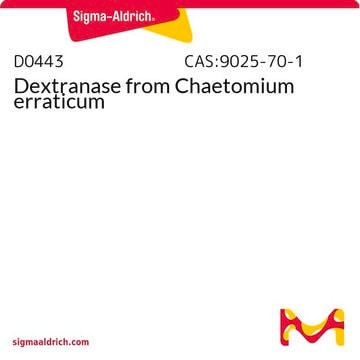D4668
Dextranase from Penicillium sp.
lyophilized powder, 100-250 units/mg protein
Synonym(s):
1,6-α-D-Glucan 6-glucanohydrolase
Sign Into View Organizational & Contract Pricing
All Photos(2)
About This Item
Recommended Products
form
lyophilized powder
Quality Level
specific activity
100-250 units/mg protein
composition
Protein, ~25% Lowry
storage temp.
2-8°C
Looking for similar products? Visit Product Comparison Guide
Application
Dextranase from Penicillium sp. can be used to modify alternan. Dextranase from Penicillium sp. has also been used in a study that explored the possibility that the Dex protein might adopt a fold unfamiliar to any known structure.
Biochem/physiol Actions
The product is an endodextranase that hydrolyzes α-(1,6)-glucosidic linkages in dextran. Dextrans are undesirable compounds synthesized from sucrose by microbial contaminants during sugar production. They increase viscosity of the flow and decrease industrial recovery. Dextranase has been used for hydrolyzing dextran at sugar mills in order to improve efficiency of sugar production.
Unit Definition
One unit will liberate 1.0 μmole of isomaltose (measured as maltose) per min at pH 6.0 at 37 °C, using dextran as substrate.
Physical form
Partially purified, lyophilized powder
Other Notes
View more information on enzymes for complex carbohydrate analysis at www.sigma-aldrich.com/enzymeexplorer
Signal Word
Danger
Hazard Statements
Precautionary Statements
Hazard Classifications
Resp. Sens. 1
Storage Class Code
11 - Combustible Solids
WGK
WGK 1
Flash Point(F)
Not applicable
Flash Point(C)
Not applicable
Personal Protective Equipment
dust mask type N95 (US), Eyeshields, Gloves
Certificates of Analysis (COA)
Search for Certificates of Analysis (COA) by entering the products Lot/Batch Number. Lot and Batch Numbers can be found on a product’s label following the words ‘Lot’ or ‘Batch’.
Already Own This Product?
Find documentation for the products that you have recently purchased in the Document Library.
T Pons et al.
Proteins, 31(4), 345-354 (1998-06-17)
The DEX gene encodes an extracellular dextranase (EC 3.2.1.11); this enzyme hydrolyzes the alpha(1,6) glucosidic bond contained in dextran to release small isomaltosaccharides. Sequence analysis has revealed only one homologous sequence, CB-8 protein, from Arthrobacter sp., with 30% sequence identity.
Timothy D Leathers et al.
Biotechnology letters, 31(2), 289-293 (2008-10-22)
Alternan is a unique glucan with a backbone structure of alternating alpha-(1 --> 6) and alpha-(1 --> 3) linkages. Previously, we isolated strains of Penicillium sp. that modify native, high molecular weight alternan in a novel bioconversion process to a
Controlled nanoparticle formation by enzymatic deshelling of biopolymer-stabilized nanosuspensions.
Yi-Yeoun Kim et al.
Small (Weinheim an der Bergstrasse, Germany), 5(8), 913-918 (2009-02-11)
Hongbin Zhang et al.
Wei sheng wu xue bao = Acta microbiologica Sinica, 51(4), 495-503 (2011-07-30)
To obtain new fungi producing dextranase,we screened and identified a strain F1001 showing high dextranase activities. We provided a new strain with dextranase activity for producing clinical dextran. Morphological and ITS rDNA sequences homology analysis were performed to identify the
Akira Yano et al.
Applied microbiology and biotechnology, 86(2), 615-623 (2009-11-11)
Mushrooms contain large quantities of alpha-glucans. Shiitake (Lentinula edodes), Japan's most popular edible mushroom, has been reported to contain about 6% (weight/dried weight) of alpha-(1,3)-glucan. This glucan is one of the major components of oral biofilm formed by the cariogenic
Our team of scientists has experience in all areas of research including Life Science, Material Science, Chemical Synthesis, Chromatography, Analytical and many others.
Contact Technical Service






